Analysis of Milgram's and Zimbardo's Research on Authority and Roles
VerifiedAdded on 2020/05/28
|16
|3787
|103
Report
AI Summary
This report examines two seminal studies in social psychology: Milgram's research on obedience to authority and Zimbardo's Stanford prison experiment on role conformity. Milgram's work explored the extent to which individuals would obey orders from an authority figure, even if those orders involved harming others. The report details the experimental setup, results, and implications, highlighting the shocking degree to which participants complied with instructions. Zimbardo's study investigated how individuals conform to social roles, specifically in a prison environment, and whether the behavior observed was due to situational or dispositional factors. The report outlines the design, procedures, and outcomes of Zimbardo's experiment, emphasizing the rapid adoption of roles by both guards and prisoners. Additionally, the report includes the author's own studies, exploring societal influences on obedience in young adults and conformity to roles in healthcare settings. The evaluation section offers critical analysis of both studies and their lasting contributions to the field of social psychology. The conclusion underscores the importance of these studies in understanding human behavior and their influence on our understanding of social dynamics.
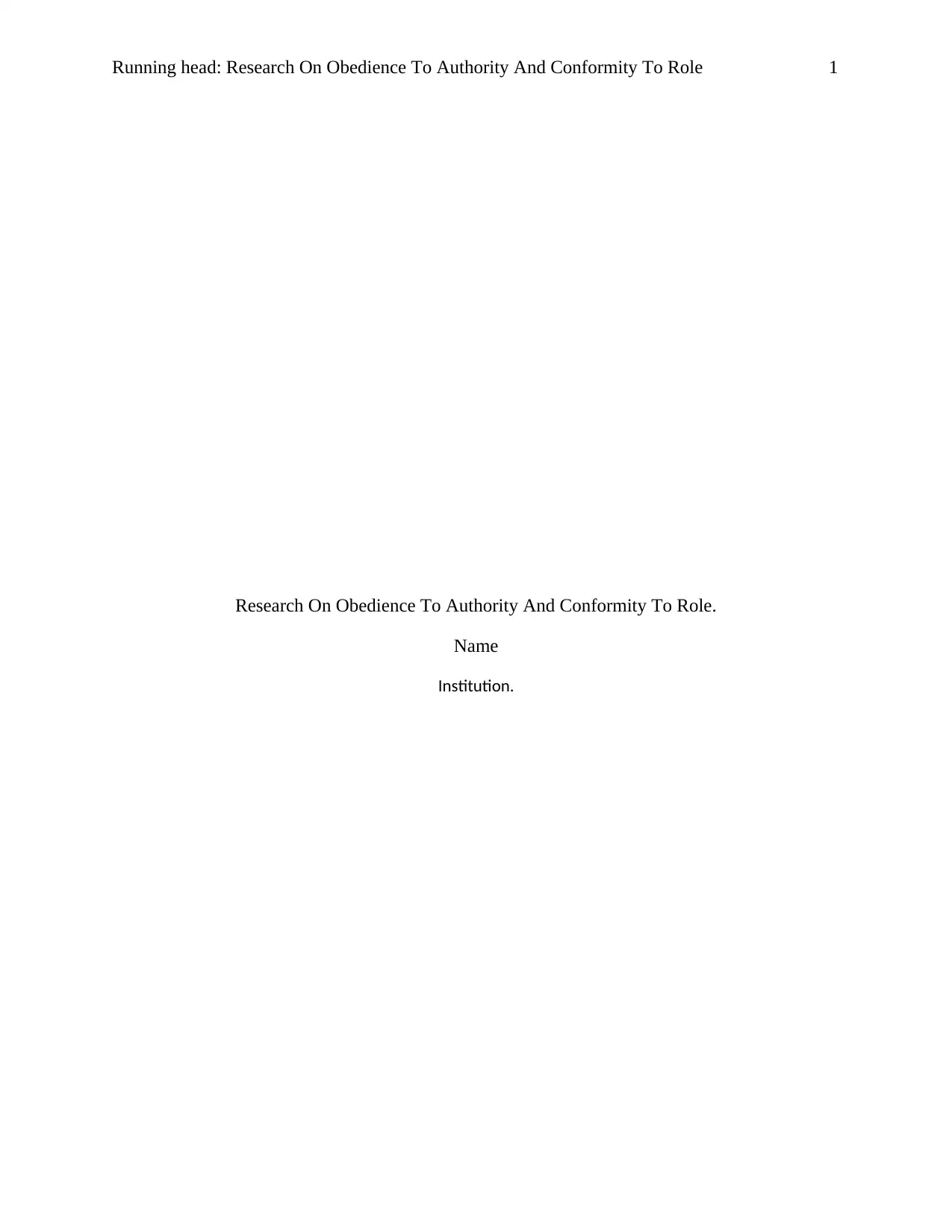
Running head: Research On Obedience To Authority And Conformity To Role 1
Research On Obedience To Authority And Conformity To Role.
Name
Institution.
Research On Obedience To Authority And Conformity To Role.
Name
Institution.
Paraphrase This Document
Need a fresh take? Get an instant paraphrase of this document with our AI Paraphraser
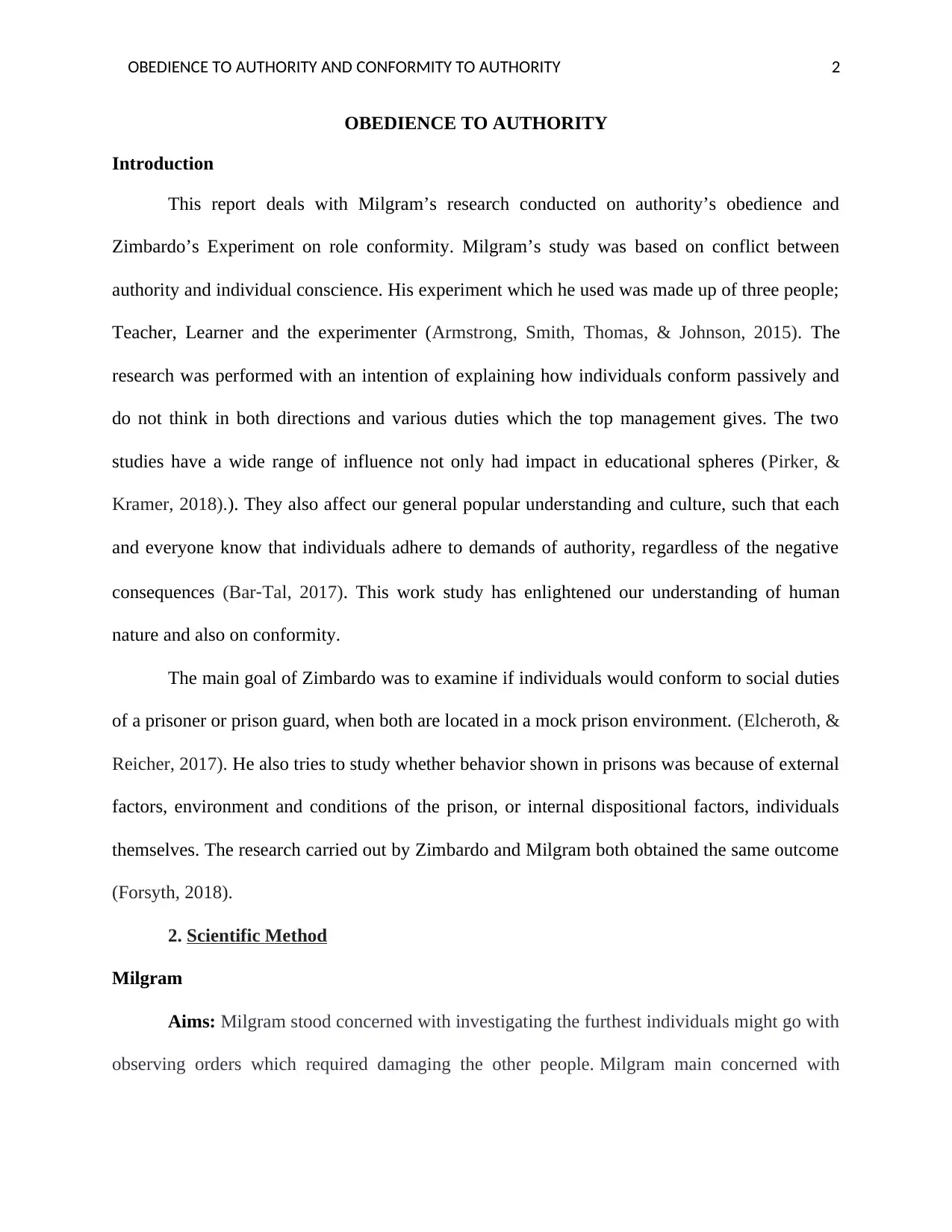
OBEDIENCE TO AUTHORITY AND CONFORMITY TO AUTHORITY 2
OBEDIENCE TO AUTHORITY
Introduction
This report deals with Milgram’s research conducted on authority’s obedience and
Zimbardo’s Experiment on role conformity. Milgram’s study was based on conflict between
authority and individual conscience. His experiment which he used was made up of three people;
Teacher, Learner and the experimenter (Armstrong, Smith, Thomas, & Johnson, 2015). The
research was performed with an intention of explaining how individuals conform passively and
do not think in both directions and various duties which the top management gives. The two
studies have a wide range of influence not only had impact in educational spheres (Pirker, &
Kramer, 2018).). They also affect our general popular understanding and culture, such that each
and everyone know that individuals adhere to demands of authority, regardless of the negative
consequences (Bar‐Tal, 2017). This work study has enlightened our understanding of human
nature and also on conformity.
The main goal of Zimbardo was to examine if individuals would conform to social duties
of a prisoner or prison guard, when both are located in a mock prison environment. (Elcheroth, &
Reicher, 2017). He also tries to study whether behavior shown in prisons was because of external
factors, environment and conditions of the prison, or internal dispositional factors, individuals
themselves. The research carried out by Zimbardo and Milgram both obtained the same outcome
(Forsyth, 2018).
2. Scientific Method
Milgram
Aims: Milgram stood concerned with investigating the furthest individuals might go with
observing orders which required damaging the other people. Milgram main concerned with
OBEDIENCE TO AUTHORITY
Introduction
This report deals with Milgram’s research conducted on authority’s obedience and
Zimbardo’s Experiment on role conformity. Milgram’s study was based on conflict between
authority and individual conscience. His experiment which he used was made up of three people;
Teacher, Learner and the experimenter (Armstrong, Smith, Thomas, & Johnson, 2015). The
research was performed with an intention of explaining how individuals conform passively and
do not think in both directions and various duties which the top management gives. The two
studies have a wide range of influence not only had impact in educational spheres (Pirker, &
Kramer, 2018).). They also affect our general popular understanding and culture, such that each
and everyone know that individuals adhere to demands of authority, regardless of the negative
consequences (Bar‐Tal, 2017). This work study has enlightened our understanding of human
nature and also on conformity.
The main goal of Zimbardo was to examine if individuals would conform to social duties
of a prisoner or prison guard, when both are located in a mock prison environment. (Elcheroth, &
Reicher, 2017). He also tries to study whether behavior shown in prisons was because of external
factors, environment and conditions of the prison, or internal dispositional factors, individuals
themselves. The research carried out by Zimbardo and Milgram both obtained the same outcome
(Forsyth, 2018).
2. Scientific Method
Milgram
Aims: Milgram stood concerned with investigating the furthest individuals might go with
observing orders which required damaging the other people. Milgram main concerned with
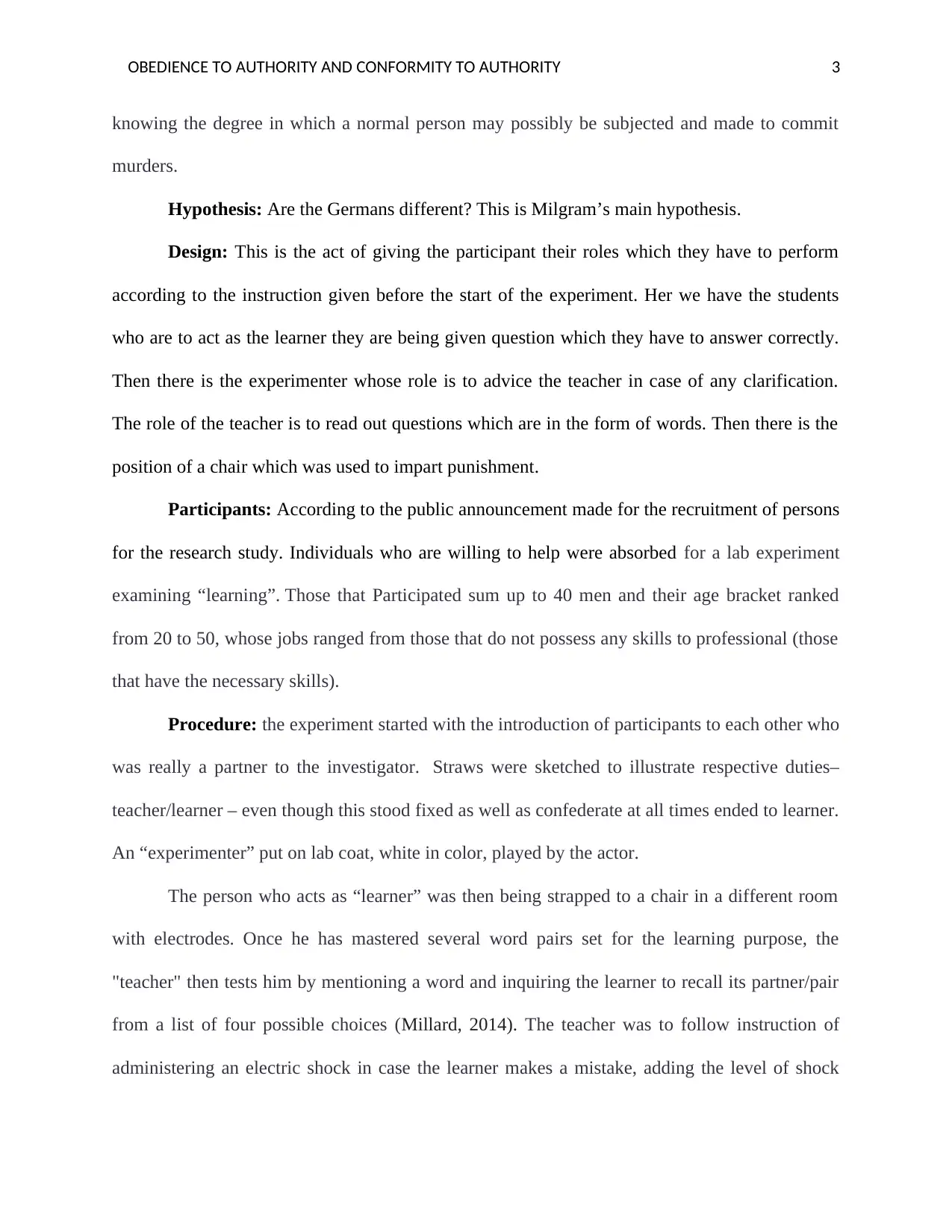
OBEDIENCE TO AUTHORITY AND CONFORMITY TO AUTHORITY 3
knowing the degree in which a normal person may possibly be subjected and made to commit
murders.
Hypothesis: Are the Germans different? This is Milgram’s main hypothesis.
Design: This is the act of giving the participant their roles which they have to perform
according to the instruction given before the start of the experiment. Her we have the students
who are to act as the learner they are being given question which they have to answer correctly.
Then there is the experimenter whose role is to advice the teacher in case of any clarification.
The role of the teacher is to read out questions which are in the form of words. Then there is the
position of a chair which was used to impart punishment.
Participants: According to the public announcement made for the recruitment of persons
for the research study. Individuals who are willing to help were absorbed for a lab experiment
examining “learning”. Those that Participated sum up to 40 men and their age bracket ranked
from 20 to 50, whose jobs ranged from those that do not possess any skills to professional (those
that have the necessary skills).
Procedure: the experiment started with the introduction of participants to each other who
was really a partner to the investigator. Straws were sketched to illustrate respective duties–
teacher/learner – even though this stood fixed as well as confederate at all times ended to learner.
An “experimenter” put on lab coat, white in color, played by the actor.
The person who acts as “learner” was then being strapped to a chair in a different room
with electrodes. Once he has mastered several word pairs set for the learning purpose, the
"teacher" then tests him by mentioning a word and inquiring the learner to recall its partner/pair
from a list of four possible choices (Millard, 2014). The teacher was to follow instruction of
administering an electric shock in case the learner makes a mistake, adding the level of shock
knowing the degree in which a normal person may possibly be subjected and made to commit
murders.
Hypothesis: Are the Germans different? This is Milgram’s main hypothesis.
Design: This is the act of giving the participant their roles which they have to perform
according to the instruction given before the start of the experiment. Her we have the students
who are to act as the learner they are being given question which they have to answer correctly.
Then there is the experimenter whose role is to advice the teacher in case of any clarification.
The role of the teacher is to read out questions which are in the form of words. Then there is the
position of a chair which was used to impart punishment.
Participants: According to the public announcement made for the recruitment of persons
for the research study. Individuals who are willing to help were absorbed for a lab experiment
examining “learning”. Those that Participated sum up to 40 men and their age bracket ranked
from 20 to 50, whose jobs ranged from those that do not possess any skills to professional (those
that have the necessary skills).
Procedure: the experiment started with the introduction of participants to each other who
was really a partner to the investigator. Straws were sketched to illustrate respective duties–
teacher/learner – even though this stood fixed as well as confederate at all times ended to learner.
An “experimenter” put on lab coat, white in color, played by the actor.
The person who acts as “learner” was then being strapped to a chair in a different room
with electrodes. Once he has mastered several word pairs set for the learning purpose, the
"teacher" then tests him by mentioning a word and inquiring the learner to recall its partner/pair
from a list of four possible choices (Millard, 2014). The teacher was to follow instruction of
administering an electric shock in case the learner makes a mistake, adding the level of shock
⊘ This is a preview!⊘
Do you want full access?
Subscribe today to unlock all pages.

Trusted by 1+ million students worldwide
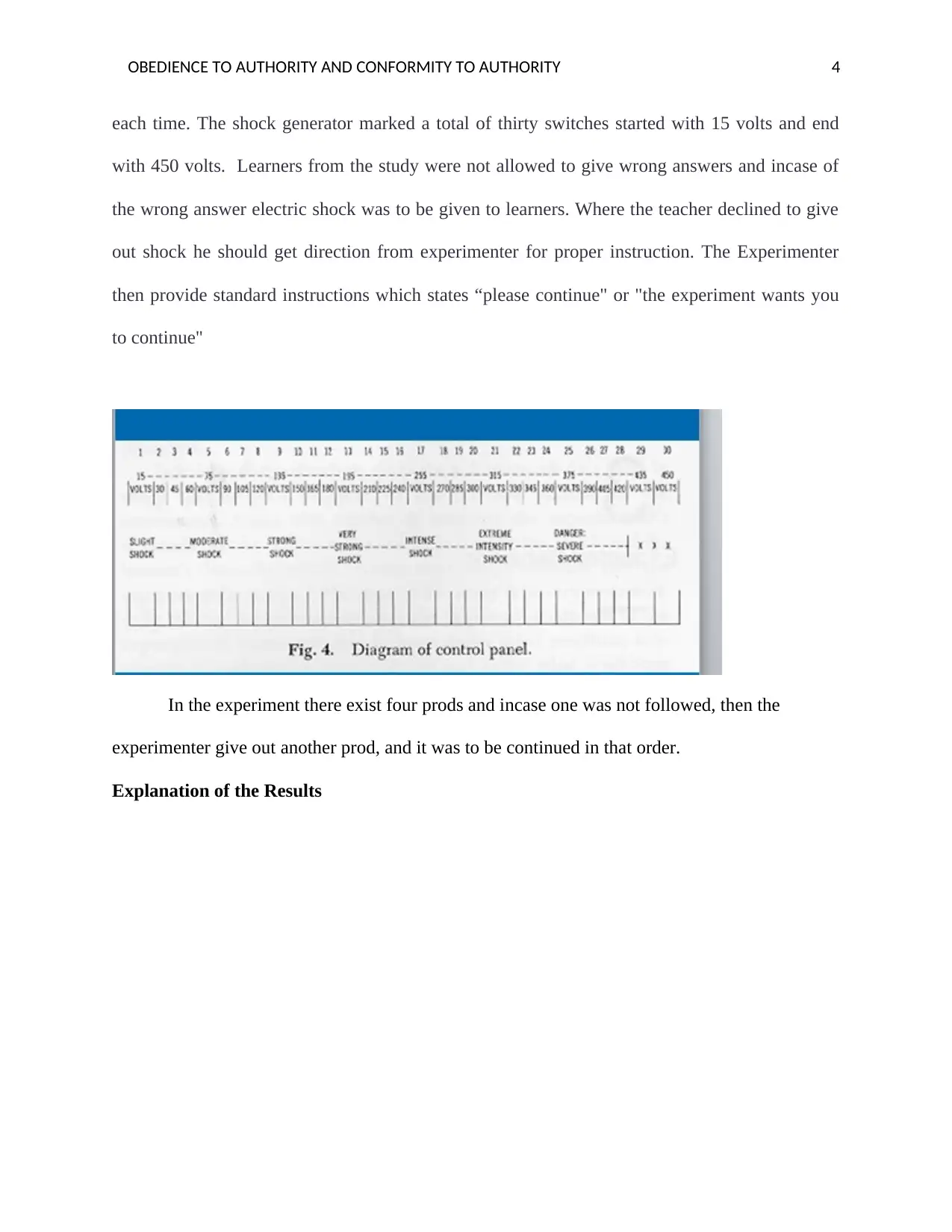
OBEDIENCE TO AUTHORITY AND CONFORMITY TO AUTHORITY 4
each time. The shock generator marked a total of thirty switches started with 15 volts and end
with 450 volts. Learners from the study were not allowed to give wrong answers and incase of
the wrong answer electric shock was to be given to learners. Where the teacher declined to give
out shock he should get direction from experimenter for proper instruction. The Experimenter
then provide standard instructions which states “please continue" or "the experiment wants you
to continue"
In the experiment there exist four prods and incase one was not followed, then the
experimenter give out another prod, and it was to be continued in that order.
Explanation of the Results
each time. The shock generator marked a total of thirty switches started with 15 volts and end
with 450 volts. Learners from the study were not allowed to give wrong answers and incase of
the wrong answer electric shock was to be given to learners. Where the teacher declined to give
out shock he should get direction from experimenter for proper instruction. The Experimenter
then provide standard instructions which states “please continue" or "the experiment wants you
to continue"
In the experiment there exist four prods and incase one was not followed, then the
experimenter give out another prod, and it was to be continued in that order.
Explanation of the Results
Paraphrase This Document
Need a fresh take? Get an instant paraphrase of this document with our AI Paraphraser
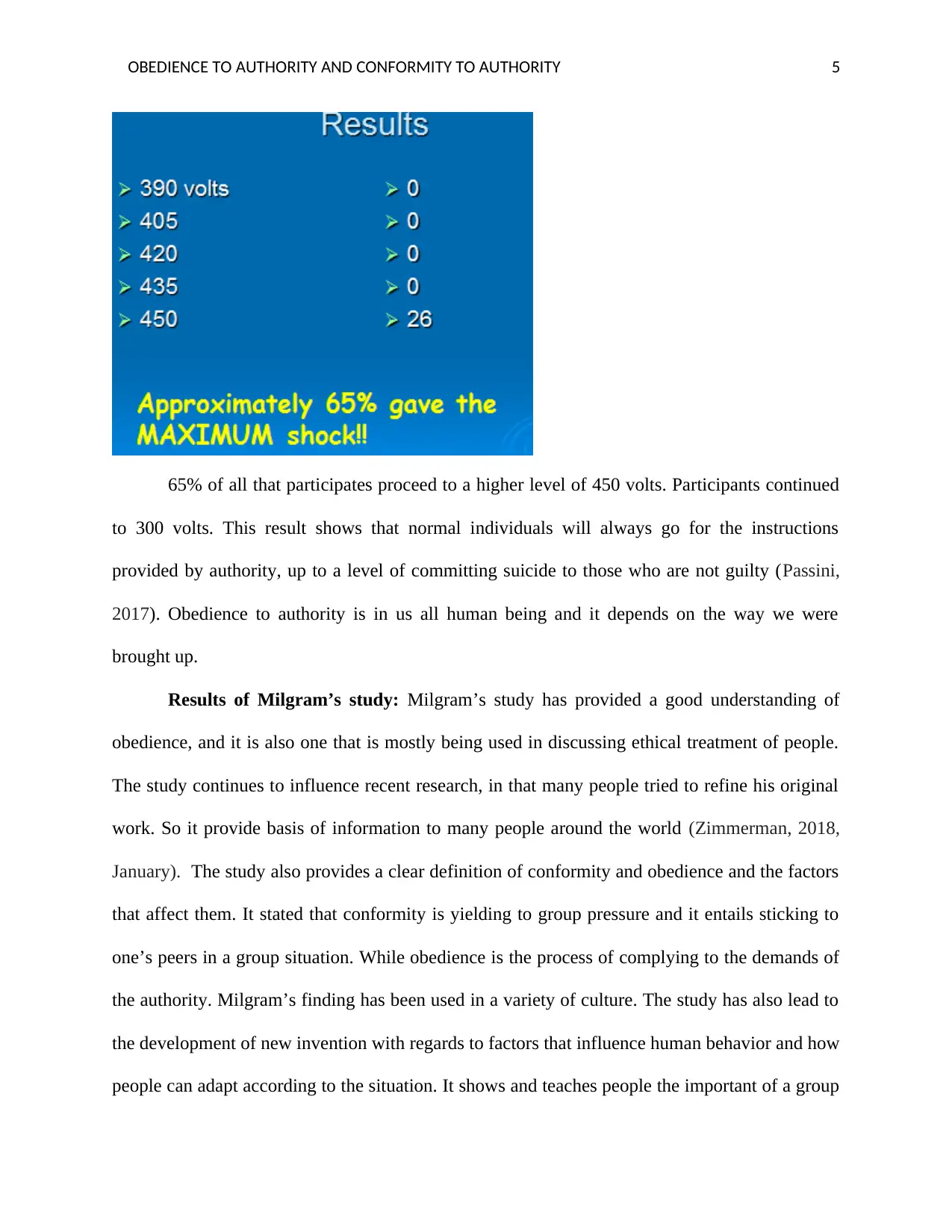
OBEDIENCE TO AUTHORITY AND CONFORMITY TO AUTHORITY 5
65% of all that participates proceed to a higher level of 450 volts. Participants continued
to 300 volts. This result shows that normal individuals will always go for the instructions
provided by authority, up to a level of committing suicide to those who are not guilty (Passini,
2017). Obedience to authority is in us all human being and it depends on the way we were
brought up.
Results of Milgram’s study: Milgram’s study has provided a good understanding of
obedience, and it is also one that is mostly being used in discussing ethical treatment of people.
The study continues to influence recent research, in that many people tried to refine his original
work. So it provide basis of information to many people around the world (Zimmerman, 2018,
January). The study also provides a clear definition of conformity and obedience and the factors
that affect them. It stated that conformity is yielding to group pressure and it entails sticking to
one’s peers in a group situation. While obedience is the process of complying to the demands of
the authority. Milgram’s finding has been used in a variety of culture. The study has also lead to
the development of new invention with regards to factors that influence human behavior and how
people can adapt according to the situation. It shows and teaches people the important of a group
65% of all that participates proceed to a higher level of 450 volts. Participants continued
to 300 volts. This result shows that normal individuals will always go for the instructions
provided by authority, up to a level of committing suicide to those who are not guilty (Passini,
2017). Obedience to authority is in us all human being and it depends on the way we were
brought up.
Results of Milgram’s study: Milgram’s study has provided a good understanding of
obedience, and it is also one that is mostly being used in discussing ethical treatment of people.
The study continues to influence recent research, in that many people tried to refine his original
work. So it provide basis of information to many people around the world (Zimmerman, 2018,
January). The study also provides a clear definition of conformity and obedience and the factors
that affect them. It stated that conformity is yielding to group pressure and it entails sticking to
one’s peers in a group situation. While obedience is the process of complying to the demands of
the authority. Milgram’s finding has been used in a variety of culture. The study has also lead to
the development of new invention with regards to factors that influence human behavior and how
people can adapt according to the situation. It shows and teaches people the important of a group
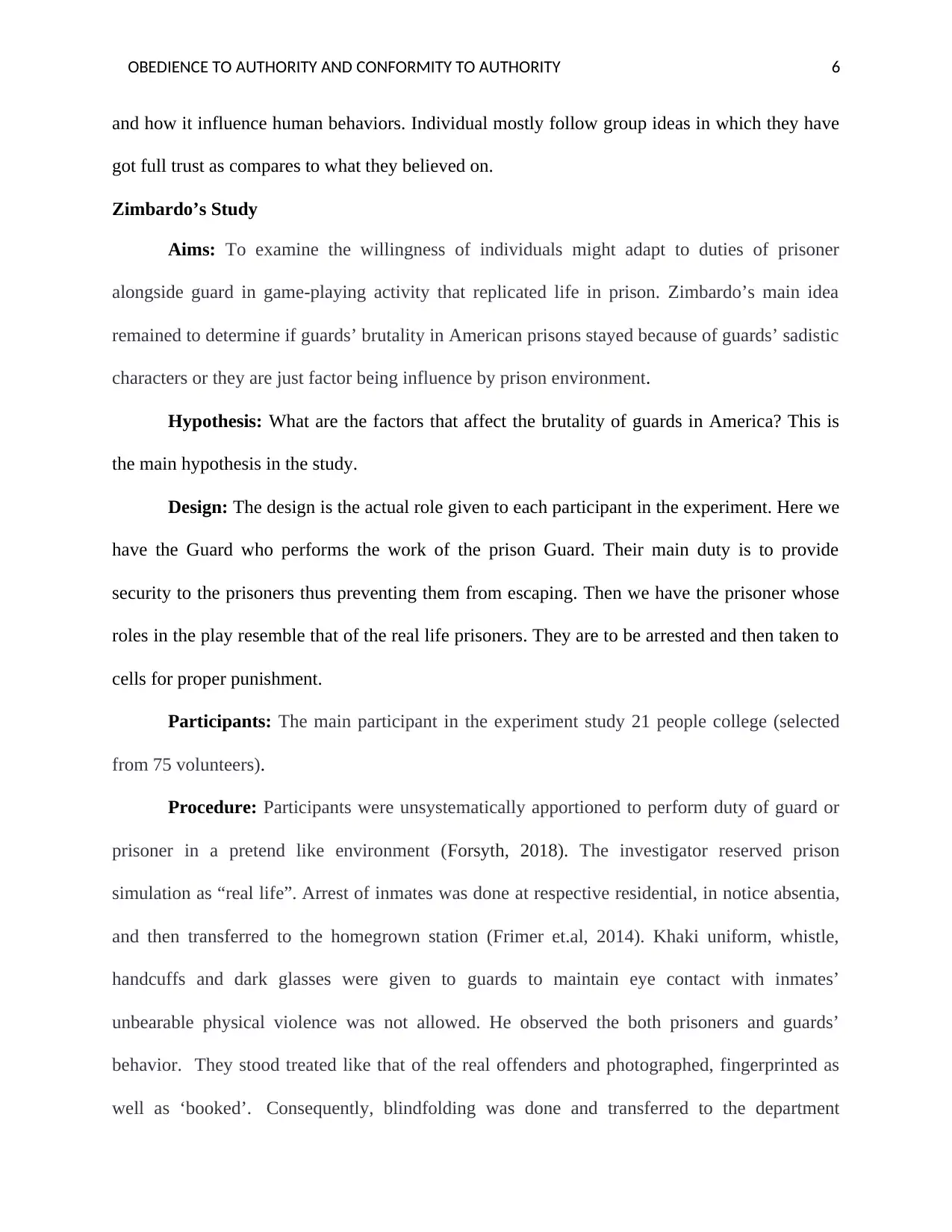
OBEDIENCE TO AUTHORITY AND CONFORMITY TO AUTHORITY 6
and how it influence human behaviors. Individual mostly follow group ideas in which they have
got full trust as compares to what they believed on.
Zimbardo’s Study
Aims: To examine the willingness of individuals might adapt to duties of prisoner
alongside guard in game-playing activity that replicated life in prison. Zimbardo’s main idea
remained to determine if guards’ brutality in American prisons stayed because of guards’ sadistic
characters or they are just factor being influence by prison environment.
Hypothesis: What are the factors that affect the brutality of guards in America? This is
the main hypothesis in the study.
Design: The design is the actual role given to each participant in the experiment. Here we
have the Guard who performs the work of the prison Guard. Their main duty is to provide
security to the prisoners thus preventing them from escaping. Then we have the prisoner whose
roles in the play resemble that of the real life prisoners. They are to be arrested and then taken to
cells for proper punishment.
Participants: The main participant in the experiment study 21 people college (selected
from 75 volunteers).
Procedure: Participants were unsystematically apportioned to perform duty of guard or
prisoner in a pretend like environment (Forsyth, 2018). The investigator reserved prison
simulation as “real life”. Arrest of inmates was done at respective residential, in notice absentia,
and then transferred to the homegrown station (Frimer et.al, 2014). Khaki uniform, whistle,
handcuffs and dark glasses were given to guards to maintain eye contact with inmates’
unbearable physical violence was not allowed. He observed the both prisoners and guards’
behavior. They stood treated like that of the real offenders and photographed, fingerprinted as
well as ‘booked’. Consequently, blindfolding was done and transferred to the department
and how it influence human behaviors. Individual mostly follow group ideas in which they have
got full trust as compares to what they believed on.
Zimbardo’s Study
Aims: To examine the willingness of individuals might adapt to duties of prisoner
alongside guard in game-playing activity that replicated life in prison. Zimbardo’s main idea
remained to determine if guards’ brutality in American prisons stayed because of guards’ sadistic
characters or they are just factor being influence by prison environment.
Hypothesis: What are the factors that affect the brutality of guards in America? This is
the main hypothesis in the study.
Design: The design is the actual role given to each participant in the experiment. Here we
have the Guard who performs the work of the prison Guard. Their main duty is to provide
security to the prisoners thus preventing them from escaping. Then we have the prisoner whose
roles in the play resemble that of the real life prisoners. They are to be arrested and then taken to
cells for proper punishment.
Participants: The main participant in the experiment study 21 people college (selected
from 75 volunteers).
Procedure: Participants were unsystematically apportioned to perform duty of guard or
prisoner in a pretend like environment (Forsyth, 2018). The investigator reserved prison
simulation as “real life”. Arrest of inmates was done at respective residential, in notice absentia,
and then transferred to the homegrown station (Frimer et.al, 2014). Khaki uniform, whistle,
handcuffs and dark glasses were given to guards to maintain eye contact with inmates’
unbearable physical violence was not allowed. He observed the both prisoners and guards’
behavior. They stood treated like that of the real offenders and photographed, fingerprinted as
well as ‘booked’. Consequently, blindfolding was done and transferred to the department
⊘ This is a preview!⊘
Do you want full access?
Subscribe today to unlock all pages.

Trusted by 1+ million students worldwide
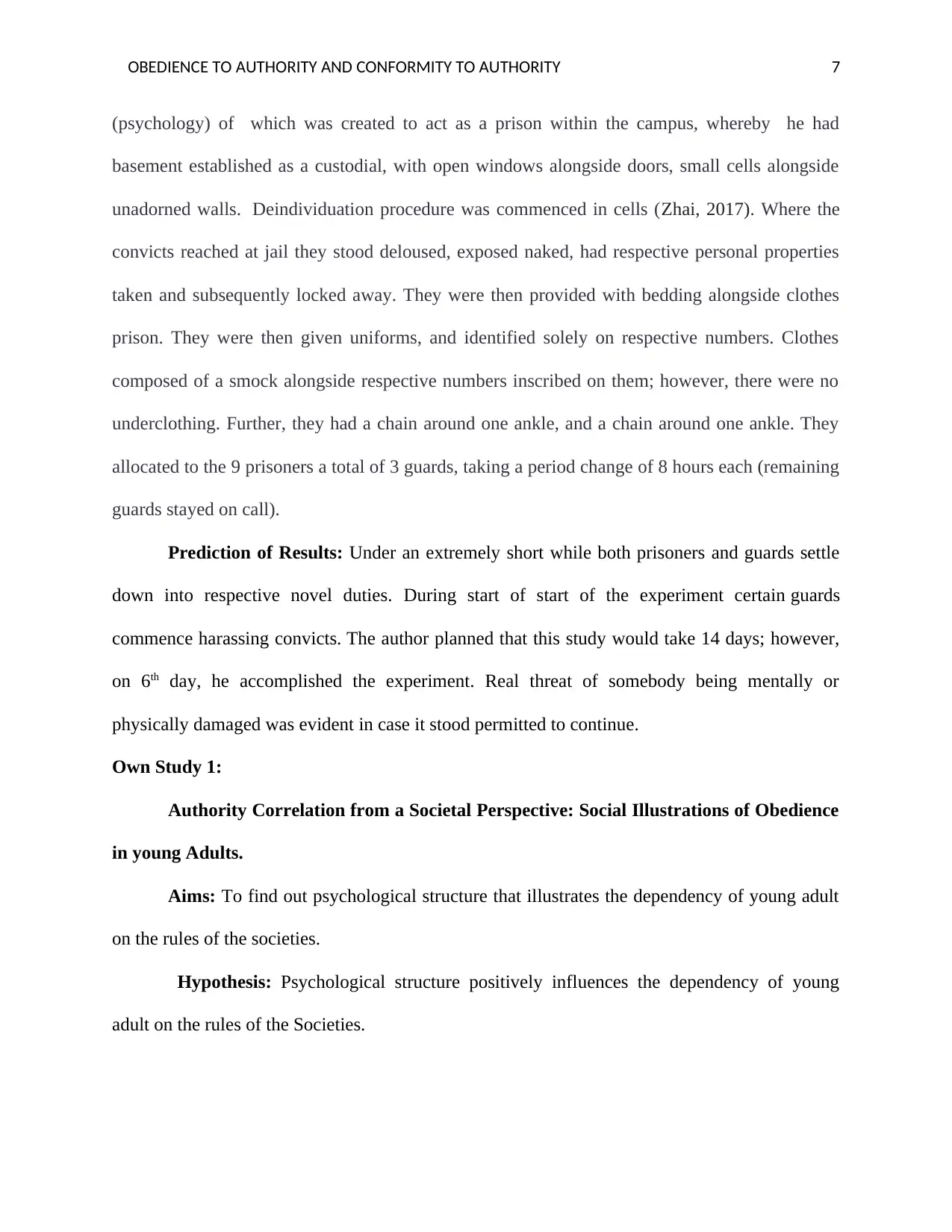
OBEDIENCE TO AUTHORITY AND CONFORMITY TO AUTHORITY 7
(psychology) of which was created to act as a prison within the campus, whereby he had
basement established as a custodial, with open windows alongside doors, small cells alongside
unadorned walls. Deindividuation procedure was commenced in cells (Zhai, 2017). Where the
convicts reached at jail they stood deloused, exposed naked, had respective personal properties
taken and subsequently locked away. They were then provided with bedding alongside clothes
prison. They were then given uniforms, and identified solely on respective numbers. Clothes
composed of a smock alongside respective numbers inscribed on them; however, there were no
underclothing. Further, they had a chain around one ankle, and a chain around one ankle. They
allocated to the 9 prisoners a total of 3 guards, taking a period change of 8 hours each (remaining
guards stayed on call).
Prediction of Results: Under an extremely short while both prisoners and guards settle
down into respective novel duties. During start of start of the experiment certain guards
commence harassing convicts. The author planned that this study would take 14 days; however,
on 6th day, he accomplished the experiment. Real threat of somebody being mentally or
physically damaged was evident in case it stood permitted to continue.
Own Study 1:
Authority Correlation from a Societal Perspective: Social Illustrations of Obedience
in young Adults.
Aims: To find out psychological structure that illustrates the dependency of young adult
on the rules of the societies.
Hypothesis: Psychological structure positively influences the dependency of young
adult on the rules of the Societies.
(psychology) of which was created to act as a prison within the campus, whereby he had
basement established as a custodial, with open windows alongside doors, small cells alongside
unadorned walls. Deindividuation procedure was commenced in cells (Zhai, 2017). Where the
convicts reached at jail they stood deloused, exposed naked, had respective personal properties
taken and subsequently locked away. They were then provided with bedding alongside clothes
prison. They were then given uniforms, and identified solely on respective numbers. Clothes
composed of a smock alongside respective numbers inscribed on them; however, there were no
underclothing. Further, they had a chain around one ankle, and a chain around one ankle. They
allocated to the 9 prisoners a total of 3 guards, taking a period change of 8 hours each (remaining
guards stayed on call).
Prediction of Results: Under an extremely short while both prisoners and guards settle
down into respective novel duties. During start of start of the experiment certain guards
commence harassing convicts. The author planned that this study would take 14 days; however,
on 6th day, he accomplished the experiment. Real threat of somebody being mentally or
physically damaged was evident in case it stood permitted to continue.
Own Study 1:
Authority Correlation from a Societal Perspective: Social Illustrations of Obedience
in young Adults.
Aims: To find out psychological structure that illustrates the dependency of young adult
on the rules of the societies.
Hypothesis: Psychological structure positively influences the dependency of young
adult on the rules of the Societies.
Paraphrase This Document
Need a fresh take? Get an instant paraphrase of this document with our AI Paraphraser
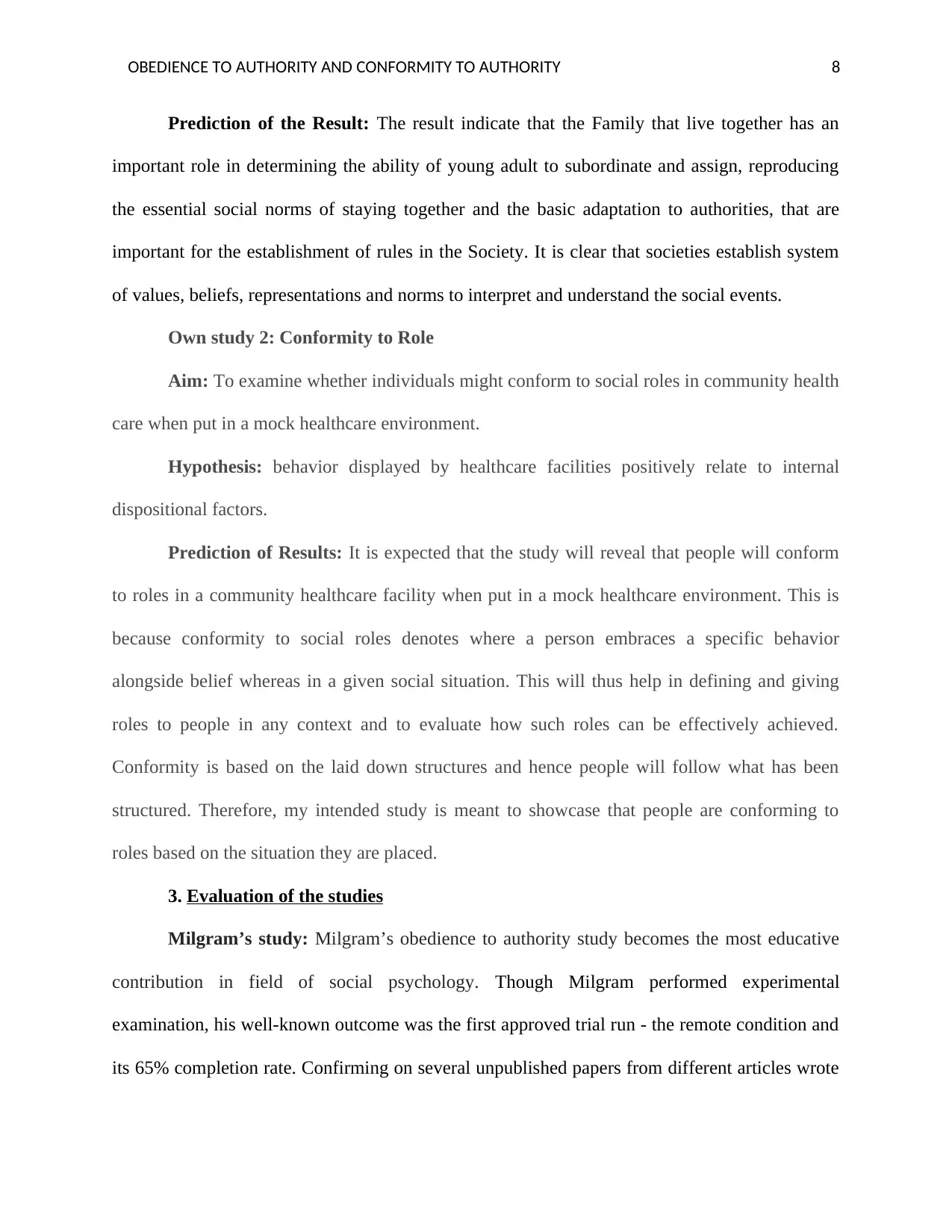
OBEDIENCE TO AUTHORITY AND CONFORMITY TO AUTHORITY 8
Prediction of the Result: The result indicate that the Family that live together has an
important role in determining the ability of young adult to subordinate and assign, reproducing
the essential social norms of staying together and the basic adaptation to authorities, that are
important for the establishment of rules in the Society. It is clear that societies establish system
of values, beliefs, representations and norms to interpret and understand the social events.
Own study 2: Conformity to Role
Aim: To examine whether individuals might conform to social roles in community health
care when put in a mock healthcare environment.
Hypothesis: behavior displayed by healthcare facilities positively relate to internal
dispositional factors.
Prediction of Results: It is expected that the study will reveal that people will conform
to roles in a community healthcare facility when put in a mock healthcare environment. This is
because conformity to social roles denotes where a person embraces a specific behavior
alongside belief whereas in a given social situation. This will thus help in defining and giving
roles to people in any context and to evaluate how such roles can be effectively achieved.
Conformity is based on the laid down structures and hence people will follow what has been
structured. Therefore, my intended study is meant to showcase that people are conforming to
roles based on the situation they are placed.
3. Evaluation of the studies
Milgram’s study: Milgram’s obedience to authority study becomes the most educative
contribution in field of social psychology. Though Milgram performed experimental
examination, his well-known outcome was the first approved trial run - the remote condition and
its 65% completion rate. Confirming on several unpublished papers from different articles wrote
Prediction of the Result: The result indicate that the Family that live together has an
important role in determining the ability of young adult to subordinate and assign, reproducing
the essential social norms of staying together and the basic adaptation to authorities, that are
important for the establishment of rules in the Society. It is clear that societies establish system
of values, beliefs, representations and norms to interpret and understand the social events.
Own study 2: Conformity to Role
Aim: To examine whether individuals might conform to social roles in community health
care when put in a mock healthcare environment.
Hypothesis: behavior displayed by healthcare facilities positively relate to internal
dispositional factors.
Prediction of Results: It is expected that the study will reveal that people will conform
to roles in a community healthcare facility when put in a mock healthcare environment. This is
because conformity to social roles denotes where a person embraces a specific behavior
alongside belief whereas in a given social situation. This will thus help in defining and giving
roles to people in any context and to evaluate how such roles can be effectively achieved.
Conformity is based on the laid down structures and hence people will follow what has been
structured. Therefore, my intended study is meant to showcase that people are conforming to
roles based on the situation they are placed.
3. Evaluation of the studies
Milgram’s study: Milgram’s obedience to authority study becomes the most educative
contribution in field of social psychology. Though Milgram performed experimental
examination, his well-known outcome was the first approved trial run - the remote condition and
its 65% completion rate. Confirming on several unpublished papers from different articles wrote
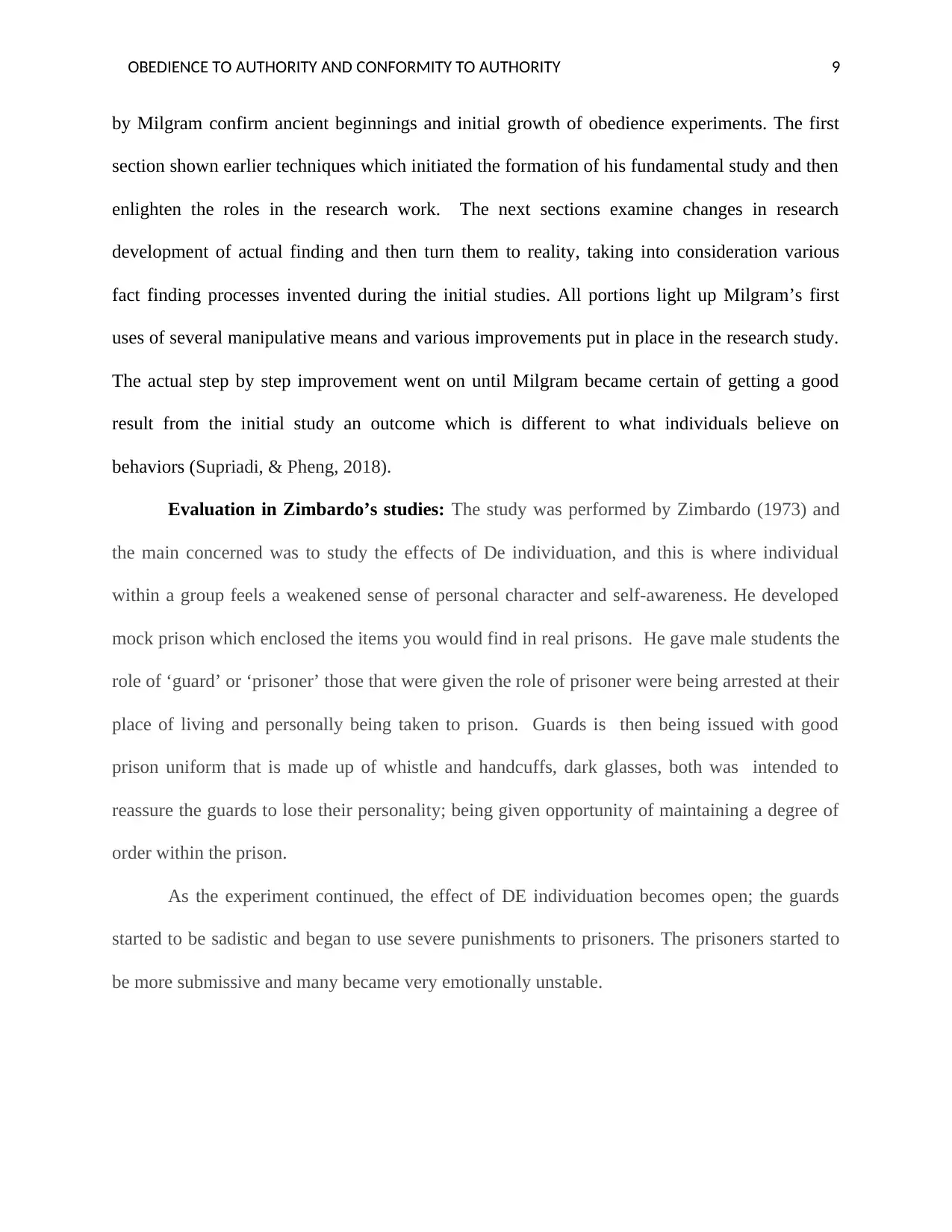
OBEDIENCE TO AUTHORITY AND CONFORMITY TO AUTHORITY 9
by Milgram confirm ancient beginnings and initial growth of obedience experiments. The first
section shown earlier techniques which initiated the formation of his fundamental study and then
enlighten the roles in the research work. The next sections examine changes in research
development of actual finding and then turn them to reality, taking into consideration various
fact finding processes invented during the initial studies. All portions light up Milgram’s first
uses of several manipulative means and various improvements put in place in the research study.
The actual step by step improvement went on until Milgram became certain of getting a good
result from the initial study an outcome which is different to what individuals believe on
behaviors (Supriadi, & Pheng, 2018).
Evaluation in Zimbardo’s studies: The study was performed by Zimbardo (1973) and
the main concerned was to study the effects of De individuation, and this is where individual
within a group feels a weakened sense of personal character and self-awareness. He developed
mock prison which enclosed the items you would find in real prisons. He gave male students the
role of ‘guard’ or ‘prisoner’ those that were given the role of prisoner were being arrested at their
place of living and personally being taken to prison. Guards is then being issued with good
prison uniform that is made up of whistle and handcuffs, dark glasses, both was intended to
reassure the guards to lose their personality; being given opportunity of maintaining a degree of
order within the prison.
As the experiment continued, the effect of DE individuation becomes open; the guards
started to be sadistic and began to use severe punishments to prisoners. The prisoners started to
be more submissive and many became very emotionally unstable.
by Milgram confirm ancient beginnings and initial growth of obedience experiments. The first
section shown earlier techniques which initiated the formation of his fundamental study and then
enlighten the roles in the research work. The next sections examine changes in research
development of actual finding and then turn them to reality, taking into consideration various
fact finding processes invented during the initial studies. All portions light up Milgram’s first
uses of several manipulative means and various improvements put in place in the research study.
The actual step by step improvement went on until Milgram became certain of getting a good
result from the initial study an outcome which is different to what individuals believe on
behaviors (Supriadi, & Pheng, 2018).
Evaluation in Zimbardo’s studies: The study was performed by Zimbardo (1973) and
the main concerned was to study the effects of De individuation, and this is where individual
within a group feels a weakened sense of personal character and self-awareness. He developed
mock prison which enclosed the items you would find in real prisons. He gave male students the
role of ‘guard’ or ‘prisoner’ those that were given the role of prisoner were being arrested at their
place of living and personally being taken to prison. Guards is then being issued with good
prison uniform that is made up of whistle and handcuffs, dark glasses, both was intended to
reassure the guards to lose their personality; being given opportunity of maintaining a degree of
order within the prison.
As the experiment continued, the effect of DE individuation becomes open; the guards
started to be sadistic and began to use severe punishments to prisoners. The prisoners started to
be more submissive and many became very emotionally unstable.
⊘ This is a preview!⊘
Do you want full access?
Subscribe today to unlock all pages.

Trusted by 1+ million students worldwide
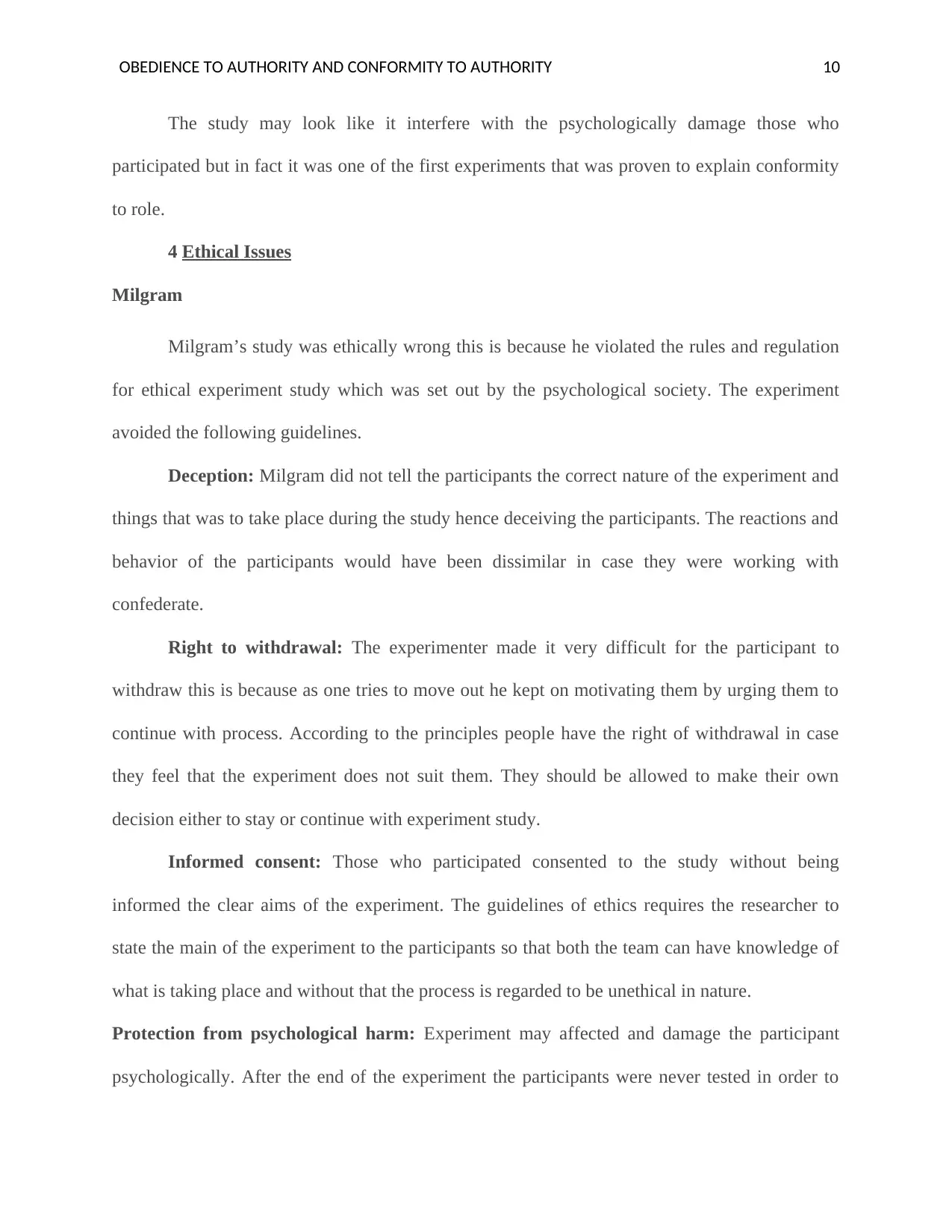
OBEDIENCE TO AUTHORITY AND CONFORMITY TO AUTHORITY 10
The study may look like it interfere with the psychologically damage those who
participated but in fact it was one of the first experiments that was proven to explain conformity
to role.
4 Ethical Issues
Milgram
Milgram’s study was ethically wrong this is because he violated the rules and regulation
for ethical experiment study which was set out by the psychological society. The experiment
avoided the following guidelines.
Deception: Milgram did not tell the participants the correct nature of the experiment and
things that was to take place during the study hence deceiving the participants. The reactions and
behavior of the participants would have been dissimilar in case they were working with
confederate.
Right to withdrawal: The experimenter made it very difficult for the participant to
withdraw this is because as one tries to move out he kept on motivating them by urging them to
continue with process. According to the principles people have the right of withdrawal in case
they feel that the experiment does not suit them. They should be allowed to make their own
decision either to stay or continue with experiment study.
Informed consent: Those who participated consented to the study without being
informed the clear aims of the experiment. The guidelines of ethics requires the researcher to
state the main of the experiment to the participants so that both the team can have knowledge of
what is taking place and without that the process is regarded to be unethical in nature.
Protection from psychological harm: Experiment may affected and damage the participant
psychologically. After the end of the experiment the participants were never tested in order to
The study may look like it interfere with the psychologically damage those who
participated but in fact it was one of the first experiments that was proven to explain conformity
to role.
4 Ethical Issues
Milgram
Milgram’s study was ethically wrong this is because he violated the rules and regulation
for ethical experiment study which was set out by the psychological society. The experiment
avoided the following guidelines.
Deception: Milgram did not tell the participants the correct nature of the experiment and
things that was to take place during the study hence deceiving the participants. The reactions and
behavior of the participants would have been dissimilar in case they were working with
confederate.
Right to withdrawal: The experimenter made it very difficult for the participant to
withdraw this is because as one tries to move out he kept on motivating them by urging them to
continue with process. According to the principles people have the right of withdrawal in case
they feel that the experiment does not suit them. They should be allowed to make their own
decision either to stay or continue with experiment study.
Informed consent: Those who participated consented to the study without being
informed the clear aims of the experiment. The guidelines of ethics requires the researcher to
state the main of the experiment to the participants so that both the team can have knowledge of
what is taking place and without that the process is regarded to be unethical in nature.
Protection from psychological harm: Experiment may affected and damage the participant
psychologically. After the end of the experiment the participants were never tested in order to
Paraphrase This Document
Need a fresh take? Get an instant paraphrase of this document with our AI Paraphraser
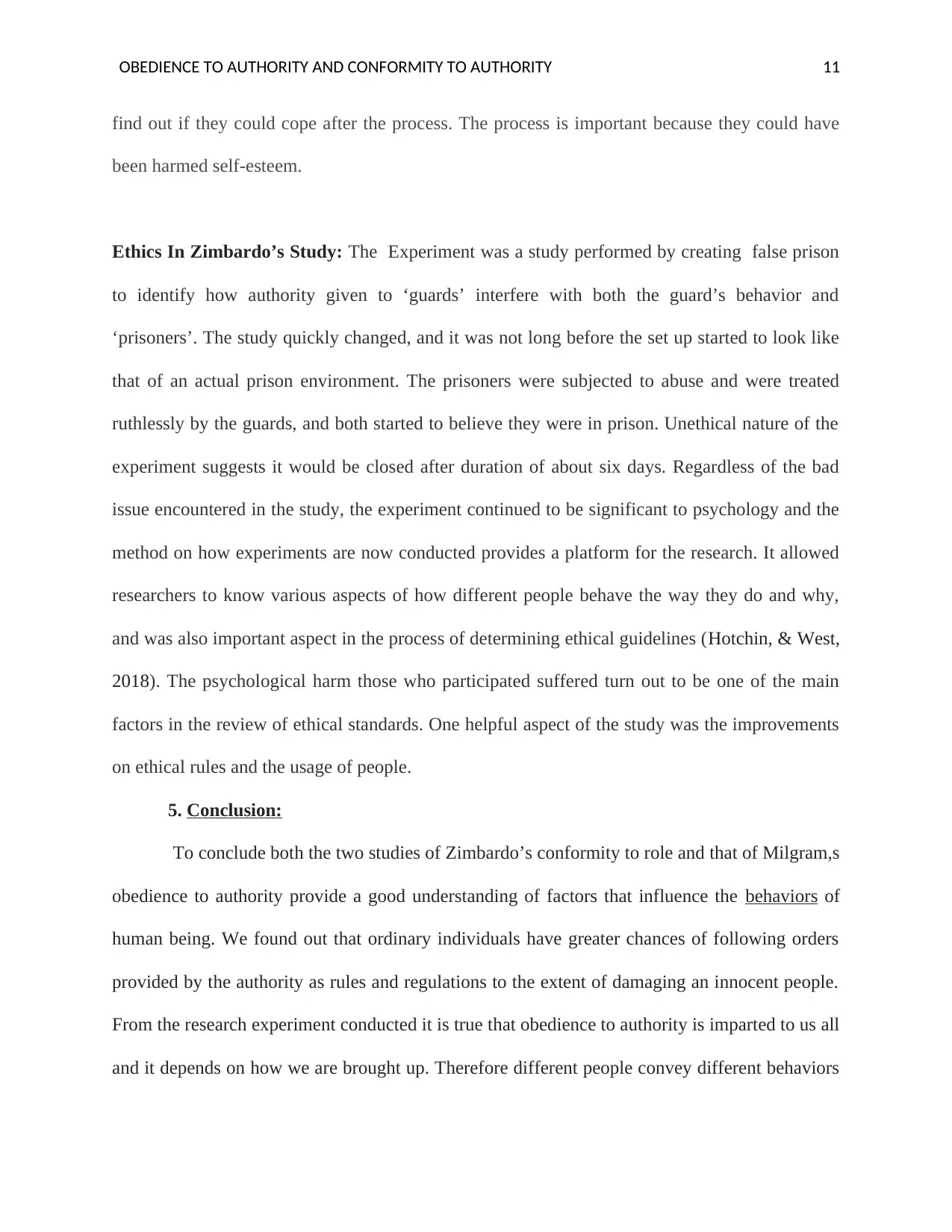
OBEDIENCE TO AUTHORITY AND CONFORMITY TO AUTHORITY 11
find out if they could cope after the process. The process is important because they could have
been harmed self-esteem.
Ethics In Zimbardo’s Study: The Experiment was a study performed by creating false prison
to identify how authority given to ‘guards’ interfere with both the guard’s behavior and
‘prisoners’. The study quickly changed, and it was not long before the set up started to look like
that of an actual prison environment. The prisoners were subjected to abuse and were treated
ruthlessly by the guards, and both started to believe they were in prison. Unethical nature of the
experiment suggests it would be closed after duration of about six days. Regardless of the bad
issue encountered in the study, the experiment continued to be significant to psychology and the
method on how experiments are now conducted provides a platform for the research. It allowed
researchers to know various aspects of how different people behave the way they do and why,
and was also important aspect in the process of determining ethical guidelines (Hotchin, & West,
2018). The psychological harm those who participated suffered turn out to be one of the main
factors in the review of ethical standards. One helpful aspect of the study was the improvements
on ethical rules and the usage of people.
5. Conclusion:
To conclude both the two studies of Zimbardo’s conformity to role and that of Milgram,s
obedience to authority provide a good understanding of factors that influence the behaviors of
human being. We found out that ordinary individuals have greater chances of following orders
provided by the authority as rules and regulations to the extent of damaging an innocent people.
From the research experiment conducted it is true that obedience to authority is imparted to us all
and it depends on how we are brought up. Therefore different people convey different behaviors
find out if they could cope after the process. The process is important because they could have
been harmed self-esteem.
Ethics In Zimbardo’s Study: The Experiment was a study performed by creating false prison
to identify how authority given to ‘guards’ interfere with both the guard’s behavior and
‘prisoners’. The study quickly changed, and it was not long before the set up started to look like
that of an actual prison environment. The prisoners were subjected to abuse and were treated
ruthlessly by the guards, and both started to believe they were in prison. Unethical nature of the
experiment suggests it would be closed after duration of about six days. Regardless of the bad
issue encountered in the study, the experiment continued to be significant to psychology and the
method on how experiments are now conducted provides a platform for the research. It allowed
researchers to know various aspects of how different people behave the way they do and why,
and was also important aspect in the process of determining ethical guidelines (Hotchin, & West,
2018). The psychological harm those who participated suffered turn out to be one of the main
factors in the review of ethical standards. One helpful aspect of the study was the improvements
on ethical rules and the usage of people.
5. Conclusion:
To conclude both the two studies of Zimbardo’s conformity to role and that of Milgram,s
obedience to authority provide a good understanding of factors that influence the behaviors of
human being. We found out that ordinary individuals have greater chances of following orders
provided by the authority as rules and regulations to the extent of damaging an innocent people.
From the research experiment conducted it is true that obedience to authority is imparted to us all
and it depends on how we are brought up. Therefore different people convey different behaviors
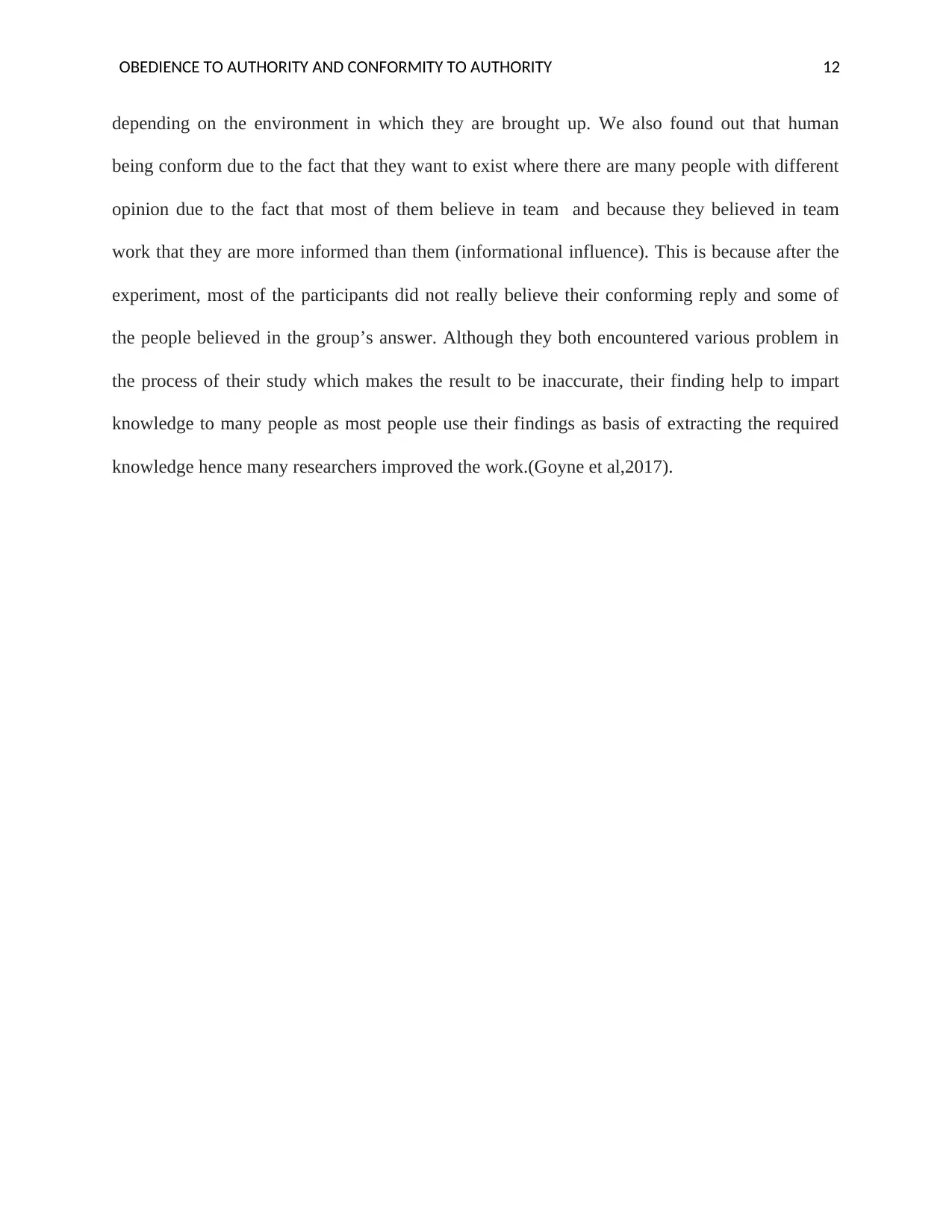
OBEDIENCE TO AUTHORITY AND CONFORMITY TO AUTHORITY 12
depending on the environment in which they are brought up. We also found out that human
being conform due to the fact that they want to exist where there are many people with different
opinion due to the fact that most of them believe in team and because they believed in team
work that they are more informed than them (informational influence). This is because after the
experiment, most of the participants did not really believe their conforming reply and some of
the people believed in the group’s answer. Although they both encountered various problem in
the process of their study which makes the result to be inaccurate, their finding help to impart
knowledge to many people as most people use their findings as basis of extracting the required
knowledge hence many researchers improved the work.(Goyne et al,2017).
depending on the environment in which they are brought up. We also found out that human
being conform due to the fact that they want to exist where there are many people with different
opinion due to the fact that most of them believe in team and because they believed in team
work that they are more informed than them (informational influence). This is because after the
experiment, most of the participants did not really believe their conforming reply and some of
the people believed in the group’s answer. Although they both encountered various problem in
the process of their study which makes the result to be inaccurate, their finding help to impart
knowledge to many people as most people use their findings as basis of extracting the required
knowledge hence many researchers improved the work.(Goyne et al,2017).
⊘ This is a preview!⊘
Do you want full access?
Subscribe today to unlock all pages.

Trusted by 1+ million students worldwide
1 out of 16
Related Documents
Your All-in-One AI-Powered Toolkit for Academic Success.
+13062052269
info@desklib.com
Available 24*7 on WhatsApp / Email
![[object Object]](/_next/static/media/star-bottom.7253800d.svg)
Unlock your academic potential
Copyright © 2020–2025 A2Z Services. All Rights Reserved. Developed and managed by ZUCOL.





